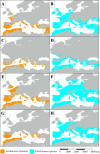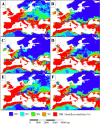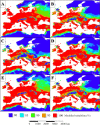The changing distribution of Leishmania infantum Nicolle, 1908 and its Mediterranean sandfly vectors in the last 140 kys
- PMID: 31413351
- PMCID: PMC6694126
- DOI: 10.1038/s41598-019-48350-7
The changing distribution of Leishmania infantum Nicolle, 1908 and its Mediterranean sandfly vectors in the last 140 kys
Abstract
The understanding of the effects of past climatic changes on the distribution of vector arthropods can strongly support the understanding of the future potential impact of anthropogenic climatic change on the geographical risk of vector-borne diseases. The zoogeographical patterns of the European sandfly vectors may suffer the continuously changing climate of the last 140 kys. The former range of L. infantum and six Phlebotomus species were modelled for the Last Interglacial, the Last Glacial Maximum and the Mid-Holocene Periods. It was found that the potential distribution of the parasite was much smaller in the Last Glacial Period L. infantum mainly could persist in the western shelves of the Mediterranean Sea. West and East Mediterranean sandfly species inhabited partly distinct refugia. The Apennine Peninsula, Sicily and the Iberian refugium formed a habitat chain along with the coastal areas of the West Mediterranean Basin. There was no direct connection between the Eastern and the Western sandfly refugia in the last 140 kys. The modelled distribution of sandfly taxa for the Middle Holocene Period can explain the relict populations of sandfly taxa in such Central European countries. The former genetic studies strongly confirm the existence of the modelled glacial refugees.
Conflict of interest statement
The authors declare no competing interests.
Figures









References
-
- Trájer AJ, Bede-Fazekas Á, Hufnagel L, Horváth L, Bobvos J. The effect of climate change on the potential distribution of the European Phlebotomus species. AEER. 2013;11:189–208. doi: 10.1371/journal.pone.0018429. - DOI
Publication types
MeSH terms
LinkOut - more resources
Full Text Sources
Miscellaneous

